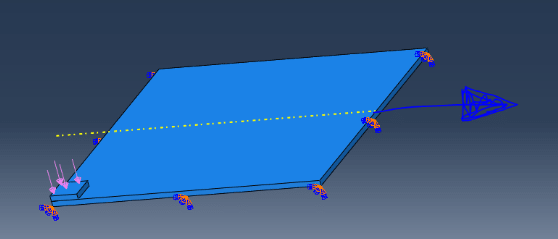Simply explained; my senior thinks I do not understand coulomb friction because I tried to incorporate FEA talk into our meeting. I am modelling plate/cube where top cube is sliding against the lower plate.

I sent him this mail explaining my results with some notes:
- Contact penetration is done using either a Lagrangian approach, or penalty method with a set of ‘springs’ acting in the surface tangent plane. We work with penalty method for penetration and shear interaction, with focus on the classical static coulomb friction.
- Two surfaces will stick up until the external shear force reaches the shear capacity (Critical shear stress), shear loading beyond this point will result in the two surfaces sliding against each other. Frictional shear capacity is limited by the contact pressure.
- There exists a static and kinetic friction: the kinetic friction coefficient is lower than static and exhibits a dependency on velocity. In this coulomb model this change to kinetic friction is ignored, and “kinetic behavior” simply becomes a constant shear capacity given by Eq.1. The stick-slip behavior is simplified to a constant capacity.

- Stiffness of the ‘springs’ in the penalty method requires a certain displacement before we reach the full frictional shear capacity (critical shear stress) - this displacement is the elastic slip.
The two graphs I sent him, first graph shows the critical shear stress which is when the cube will start to slide for different pressure values. Second figure shows how the top cube when subjected to 100 Pa will start to slide - small elastic slip before it reaches critical shear stress.

He replied with this:
Sliding occurs if there is insignificant normal pressure or if the friction shear stress is exceeded. Please show in your next meeting,
1) What is the minimum normal pressure required to prevent sliding under its own weight?
2) What are the sliding velocity and displacements for different settings of normal pressure that you have chosen, when the sticking contribution is lost (i.e. exceeding the friction shear stress limit).
I am thinking of replying him with this, and I wanna make sure it makes sense to not have a back and forth:
1)Force of gravity will pull the block to the right with force of F_grav = mg, to counteract this the friction force has to be equal to F_grav.
F_grav = mg = p*A*µ, then the pressure has to be p = (mg)/(A*µ).
Where p is the uniform pressure and A is the top surface area.
2) I believe this is shown in the figure below for 100 Pa pressure (I wrote 100 MPa which is wrong). The change in friction coefficient in the slipping condition (from static to kinetic friction) is ignored, hence why the kinematic behavior becomes that of a constant shear capacity, dependency on the slip rate (velocity) is therefore in this model ignored. The sliding displacement is shown in the right part of the second figure, this occurs after the elastic slip, dotted line.

I sent him this mail explaining my results with some notes:
- Contact penetration is done using either a Lagrangian approach, or penalty method with a set of ‘springs’ acting in the surface tangent plane. We work with penalty method for penetration and shear interaction, with focus on the classical static coulomb friction.
- Two surfaces will stick up until the external shear force reaches the shear capacity (Critical shear stress), shear loading beyond this point will result in the two surfaces sliding against each other. Frictional shear capacity is limited by the contact pressure.
- There exists a static and kinetic friction: the kinetic friction coefficient is lower than static and exhibits a dependency on velocity. In this coulomb model this change to kinetic friction is ignored, and “kinetic behavior” simply becomes a constant shear capacity given by Eq.1. The stick-slip behavior is simplified to a constant capacity.

- Stiffness of the ‘springs’ in the penalty method requires a certain displacement before we reach the full frictional shear capacity (critical shear stress) - this displacement is the elastic slip.
The two graphs I sent him, first graph shows the critical shear stress which is when the cube will start to slide for different pressure values. Second figure shows how the top cube when subjected to 100 Pa will start to slide - small elastic slip before it reaches critical shear stress.

He replied with this:
Sliding occurs if there is insignificant normal pressure or if the friction shear stress is exceeded. Please show in your next meeting,
1) What is the minimum normal pressure required to prevent sliding under its own weight?
2) What are the sliding velocity and displacements for different settings of normal pressure that you have chosen, when the sticking contribution is lost (i.e. exceeding the friction shear stress limit).
I am thinking of replying him with this, and I wanna make sure it makes sense to not have a back and forth:
1)Force of gravity will pull the block to the right with force of F_grav = mg, to counteract this the friction force has to be equal to F_grav.
F_grav = mg = p*A*µ, then the pressure has to be p = (mg)/(A*µ).
Where p is the uniform pressure and A is the top surface area.
2) I believe this is shown in the figure below for 100 Pa pressure (I wrote 100 MPa which is wrong). The change in friction coefficient in the slipping condition (from static to kinetic friction) is ignored, hence why the kinematic behavior becomes that of a constant shear capacity, dependency on the slip rate (velocity) is therefore in this model ignored. The sliding displacement is shown in the right part of the second figure, this occurs after the elastic slip, dotted line.
